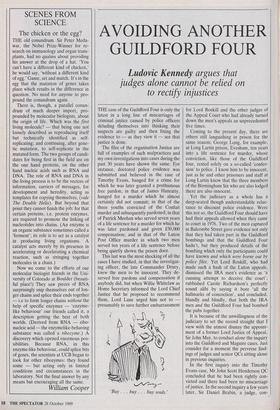SCENES FROM SCIENCE
The chicken or the egg?
THE old conundrum. Sir Peter Meda- war, the Nobel Prize-Winner for re- search on immunology and organ trans- plants, had no qualms about providing his answer at the drop of a hat. 'You can't have a different kind of chicken,' he would say, 'without a different kind of egg.' Game, set and match. It's in the egg that the mutation of genes takes place which results in the difference in question. No need for anyone to pro- pound the conundrum again.
There is, though, a parallel conun- drum of much deeper import, pro- pounded by molecular biologists, about the origin of life. Which was the first living molecule? — that being one not loosely described as reproducing itself but technically identified as self- replicating; and continuing, after gene- tic mutation, to self-replicate in the mutated form. The two groups of candi- dates for being first in the field are on the one hand proteins, on the other hand nucleic acids such as RNA and DNA. The role of RNA and DNA in the living process is to be the vectors of information, carriers of messages, for development and heredity, acting as templates for copying themselves, (vide The Double Helix). But beyond that point they cannot finish the job: for that certain proteins, i.e. protein enzymes, are required to promote the linking of nucleotides into chains. (An enzyme is an organic substance sometimes called a `ferment'; its role is to act as a catalyst in producing living organisms. A catalyst acts merely by its presence in accelerating or decelerating a chemical reaction, such as stringing together molecules in a chain.) Now we come to the efforts of our molecular biologist friends in the Uni- versity of Colorado at Boulder (beauti- ful place!) They saw pieces of RNA surprisingly snip themselves out of lon- ger chains and splice their ends together — i.e to form longer chains without the help of specific enzymes — `enzyme- like behaviour' our friends called it, a description getting the best of both worlds. (Derived from RNA — ribo- nucleic acid — the enzymelike-behaving substance was called a ribozyme.) A discovery which opened enormous pos- sibilities. Because RNA, in this enzyme-like behaviour, could splice bits of genes, the scientists at UCB began to look for other ribozymes: they found some — but acting only in limited conditions and circumstances in the laboratory. Not the final answer by any means but encouraging all the same.
William Cooper


































































 Previous page
Previous page